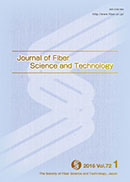
- |<
- <
- 1
- >
- >|
-
Ryoko Yasukawa, Yuri Sakai, Hirohisa Yamada, Keiko Gotoh2018 Volume 74 Issue 6 Pages 122-132
Published: June 10, 2018
Released on J-STAGE: June 16, 2018
JOURNAL OPEN ACCESSThe effect of the atmospheric pressure plasma jet (APPJ) pre-treatment on the inkjet dyeing of wool fabric with acid dyes was examined. The scanning electron microscopic observation and the X-ray photoelectron spectroscopic analysis reveled the topographical change and atomic oxygen increase in the fiber surface. Especially for short steaming time and milling type dyes, the Kubelka-Munk function value of the dyed fabric as a measure of the colour deepening increased due to the pre-treatment by the APPJ compared with the chemicals containing urea and sizing agent. It was confirmed from image analysis that the APPJ treatment did not cause bleeding and uneven dyeing. The colour fastness of the dyed fabric to washing and rubbing did not reduce due to the pre-treatments by APPJ as well as chemicals. It is expected that introduction of the APPJ pre-treatment to the inkjet dyeing is effective to reduce environmental impact and to improve energy efficiency and productivity in the dyeing process.
View full abstractDownload PDF (5123K) -
- A Key to Understand the Crystallization of Oriented PolymerMasatoshi TOSAKA, Shohei OUE, Alice GROS, Bertrand HUNEAU, Erwan VERRO ...2018 Volume 74 Issue 6 Pages 133-142
Published: June 10, 2018
Released on J-STAGE: June 16, 2018
JOURNAL OPEN ACCESSIn order to demonstrate that lower surface energies of bundle-like crystals have a dominant effect for the enhancement of strain-induced crystallization of natural rubber (NR), an estimation of the end-surface energy (σe) was attempted. NR samples were quickly stretched at predetermined crystallization temperature (Tc) to a prescribed draw ratio (αs), and the wide angle X-ray diffraction patterns during the subsequent stepwise heating process were investigated. Melting temperature (Tm) was found to depend solely on αs and to be independent of Tc. Simultaneously, average crystallite size in the chain direction (〈Lc〉) was primarily determined by network-chain density and was also independent of Tc. As a result, the plot of Tm versus〈Lc〉-1 suggested that σe is negligibly low and estimated Tm is an approximation of the equilibrium melting temperature.
View full abstractDownload PDF (3696K)
-
Lei Zhang, Ying Wang, Xing Yang2018 Volume 74 Issue 6 Pages 143-149
Published: June 10, 2018
Released on J-STAGE: June 16, 2018
JOURNAL OPEN ACCESSIn order to obtain a green solvent for chitosan, plasma acid was prepared by dielectric barrier discharge of water. The results showed that the maximum saturated solubility of chitosan in the plasma acid at pH of 1.25 was 1%. Then 1% chitosan membrane, 0.5% graphene oxide (GO) and 1% chitosan composite membrane were prepared using plasma acid as solvent. The structure and properties of GO/chitosan composite membrane were investigated carefully by thermal-gravimetric, scanning electron microscope,X-ray diffraction, Fourier transform infrared spectroscopy and mechanical property analysis. After adding GO into the chitosan solution, the GO was dispersed uniformly in the matrix. There was a strong interaction between GO and chitosan matrix, which prevented the aggregation of graphene effectively. The surface of the composite membrane became smooth. The thermal stability of GO/chitosan composite membrane was increased. It had good mechanical properties. In a word, plasma acid could be used as a green solvent, the performance of chitosan membrane was improved after adding GO. It has the potential application in the field of biomedicine and textiles.
View full abstractDownload PDF (2738K)
- |<
- <
- 1
- >
- >|